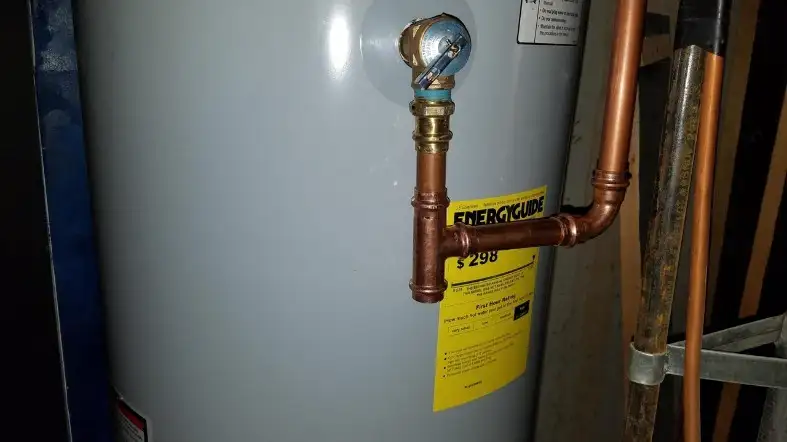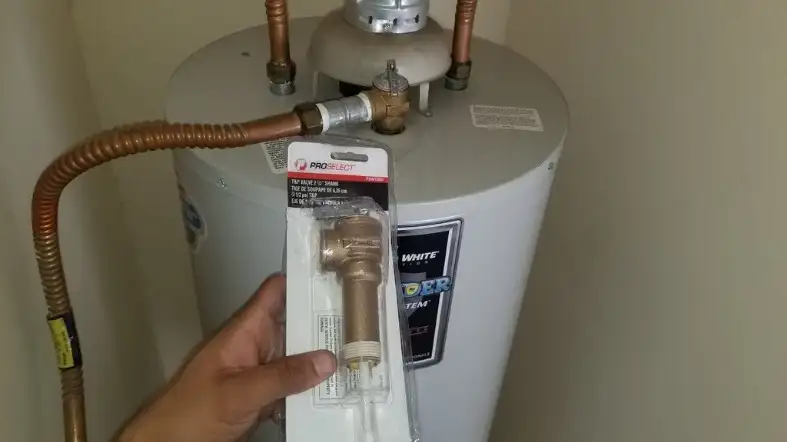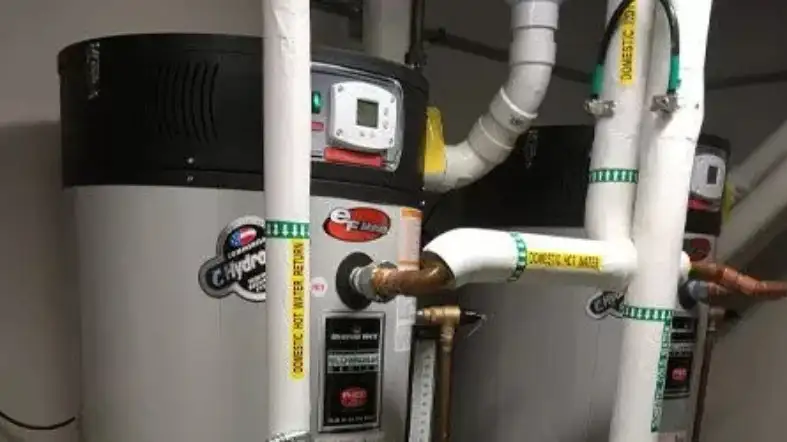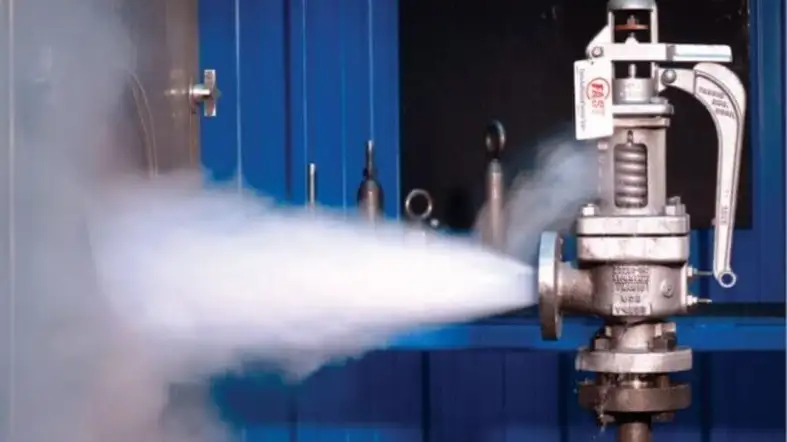One cannot overstate how crucial it is to have a correct-sized pressure relief valve for a water heater.
If you want your water heater to work properly and efficiently, it is the first thing to do.
Both replacement relief valves and brand-new vessels fall under this.
What size pressure relief valve for water heater is deemed to be perfect? Well, it depends on a few factors.

What Size Pressure Relief Valve is For the Water Heater?
For most residential water heaters, a 3/4″ NPT (National Pipe Thread) pressure relief valve is recommended. It’s suitable for relieving both pressure and temperature in most standard 30-50 gallon residential water heaters up to 150 psi. For larger tanks up to 120 gallons, use 1″ and 1 1/4″ NPT size.
Water Heater Pressure Relief Valve Size Chart:
| Water Heater Tank Size | Pressure Relief Valve Size |
|---|---|
| 30-50 gallons (standard residential) | 3/4″ NPT |
| 60-80 gallons (medium residential) | 3/4″ or 1″ NPT |
| 80-120 gallons (large residential) | 1″ or 1 1/4″ NPT |
Available Size Of Pressure Relief Valve For Water Heater
The consideration here is very simple. There is no standard size for any given water heater. So, considering the valve and heater rating, the list can be like this.
| Heater Rating (MAWP) | Valve Rating |
|---|---|
| 125 PSI | 125 PSI or Less |
| 150 PSI | 150 PSI or Less |
| 160 PSI | 150 PSI maximum |

Why Is Valve Size Important?
Valve size refers to the diameter of the valve opening in a pipeline, and it is an essential consideration when designing and selecting valves for a specific application.
Here are some issues on why valve size is important:

Flow rate:
The valve size affects the flow rate through the pipeline. A larger valve size can allow for higher flow rates, while a smaller valve size can restrict the flow.
Pressure drop:
The valve size can impact the pressure drop across the valve. A smaller valve size can cause a higher pressure drop, which can reduce the efficiency of the system.
Velocity:
The velocity of the fluid passing through the valve can be affected by the valve size.
A smaller valve size can cause higher velocities, which can lead to erosion, corrosion, or other damage to the pipeline.
Cavitation:
If the valve size is too small, it can lead to cavitation, which is the formation of vapor bubbles in the liquid.
These bubbles can collapse and cause damage to the valve and the pipeline.
Cost:
The valve size can also impact the cost of the valve and the system.
Larger valves are generally more expensive than smaller ones, so selecting the right size valve is essential to balancing cost and performance.
What is the best tankless water heater for 5 family members?
How Does A Pressure Relief Valve Work?

A pressure relief valve is a type of safety valve used to protect equipment and systems from overpressure.
It works by opening when the pressure inside a vessel or system exceeds a predetermined set pressure, allowing excess pressure to be safely released.
Here’s how a pressure relief valve works:
Spring-loaded mechanism:
Pressure relief valves typically have a spring-loaded mechanism that keeps the valve closed under normal operating conditions.
The spring is calibrated to a specific pressure, which is determined by the system’s design and requirements.
Set pressure:
When the pressure inside the system exceeds the set pressure of the valve, the force exerted by the fluid overcomes the spring force and opens the valve.
Valve opening:
As the valve opens, the excess pressure is safely released from the system, preventing damage to the equipment or system.
The valve remains open until the pressure drops below the set pressure, at which point the spring force pushes the valve back into the closed position.
Pressure regulation:
Pressure relief valves can be designed to regulate pressure continuously, which is known as proportional relief.
They can be designed to open fully once the set pressure is reached, which is known as pop action.
Safety features:
Pressure relief valves can also have additional safety features, such as an external lever or weights that can manually lift the valve if the spring fails or the system loses pressure.
Sizing the pressure relief valve
To size the pressure relief valve for a water heater, you will need to calculate the required capacity of the valve based on the water heater specifications.
Determine the water heater capacity in gallons
This can typically be found on the manufacturer’s label or in the owner’s manual.
Determine the water heater BTU rating
- This can also be found on the manufacturer’s label or in the owner’s manual.
Calculate the BTU input per hour of the water heater
- Multiply the water heater capacity (in gallons) by 8.33 (the weight of a gallon of water)
- Multiply that result by the temperature rise (in degrees Fahrenheit)
- Multiply that result by 1.0 (specific heat of water)
- The result is the BTU input per hour of the water heater.
Determine the operating pressure of the water heater
The operating pressure of the water heater is typically specified by the manufacturer and can be found in the owner’s manual or on the manufacturer’s label.
Calculate the required capacity of the pressure relief valve
- Multiply the BTU input per hour by 0.00094 (a constant factor used to calculate the required capacity of the valve)
- Divide that result by the operating pressure of the water heater in PSI
- The result is the required capacity of the pressure relief valve in pounds per hour (lbs/hr).
Choose the correct valve size
Once you have calculated the required capacity of the pressure relief valve, you can choose the correct valve size based on the manufacturer’s specifications and industry standards.
FAQs about what size pressure relief valve for the water heater
Does The Length Of The Pressure Relief Valve Matter?
Yes, the length of the pressure relief valve matters a lot.
It ultimately determines how efficient the contract the valve has with the water.
So, a longer valve is okay, but a shorter one is never acceptable.
What Size Thread Is The Pressure Relief Valve On A Water Heater?
A 3/4-inch NPT or National Pipe Thread works perfectly for most of the pressure relief valves for the water heaters.
So, check it out and buy one of this size.
Can You Use PVC For The Water Heater Relief Valve?
No, the hot water building code doesn’t approve PVC.
It takes a lot of time to release the valve.
So, it is unsafe, and you should avoid it.
Are Water Heater Pressure Relief Valves Adjustable?
No, they come with one fixed capacity.
So, you cannot adjust them. The usual size ranges from 120-150 PSI.
Choose a valve that matches the PSI capacity of the water heater.
Why Does A Pressure Relief Valve Fail?
Due to rust and corrosion accumulation inside the tank, the valve frequently becomes stuck or becomes locked in position.
The valve may be jammed as a result of a previous hot water discharge. The valve size has nothing to do with it.
Final Words
As you already know what size pressure relief valve is for a water heater and what factors influence its size, you are good to go.
So, once you have an accurate capacity pressure relief valve, you are good to go. You can enjoy a warm bath with utmost safety.
